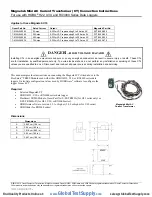
32
Using the Memory
The FT3DR/DE transceiver incorporates a Large number of memory channels that can
register the operating frequency, communication mode, and other operational informa-
tion.
z
900 Memory Channels
z
99 Skip Search Memory Channels
z
11 Home Channels
z
50 pairs PMS Memory Channels
z
Preset Receiver Memory Channels include the International VHF marine radio (57
channels) and Worldwide Wide Broadcasts (89 channels)
The operating frequency and other operational information can be registered to each
regular memory channel, home channel, or PMS memory channel:
• Operating frequency • Operation Mode • Frequency Step • Transmitter output
• Memory tag
• Repeater Shift
• TX/RX DG-ID
• Tone information
• DCS information
• ATT
• S meter squelch • FM mode bandwidth
• Memory channel skip information
• Specified Memory Channel
Memory channels can be sorted and registered into memory banks according to the in-
tended use. The transceiver allows using 24 types of memory banks. A maximum of 100
memory channels can be registered in each memory bank.
900
899
4
3
2
1
L50/U50
L49/U49
L4/U4
L3/U3
L2/U2
L1/U1
904
903
902
901
999
998
Memory Channel Configuration of the Transceiver
Memory Channels
(900 channels)
AIR Band
HOME channels
(11 channels)
Memory Banks
(24 banks)
Up to 100 memory channels can be
registered to each bank.
Skip search memory channels
(99 channels)
PMS Memory channels
(50 sets)
Preset receiver memory channels
Memory channels for short wave broadcasts
(89 channels) and international VHF (marine)
radios (57 channels)
FM BC Band
AM BC Band
50 MHz Band
144 MHz Band
430 MHz Band
SW Band
VHF (1)
VHF (2)
UHF (1)
UHF (2)
Caution
The information registered to memory channels can be corrupted by incorrect operation, static
electricity, or electrical noise. Also, it can be erased in the event of a failure or repair. Be sure
to keep a record of the settings on paper or back up the data to the microSD memory card. For
details on saving a backup onto a microSD memory card, see “Set Mode: SD CARD Menu Opera-
















































